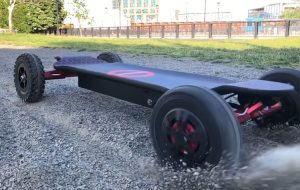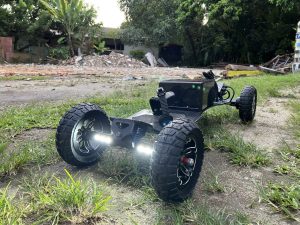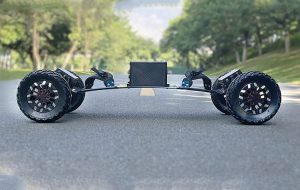Electric skateboards and scooters offer similar conveniences to electric transportation but differ considerably in performance, usability, and riding experience. Let’s compare these two modes of transport to see which may be a better fit for your lifestyle.

Electric Skateboard Pros and Cons
| Pros | Cons |
|---|---|
| Thrilling ride: Electric skateboards can reach speeds of up to 35 mph, offering a thrill and excitement that standard skateboards cannot match. The acceleration provided by the electric motor gives riders a sense of freedom and exhilaration. | Steep learning curve: Although easier to maneuver than regular skateboards, electric skateboards still have a learning curve, especially at higher speeds. Beginners may struggle with balancing, turning, and braking effectively. |
| Easy to maneuver: Unlike scooters, electric skateboards are easy to turn, carve, and maneuver, thanks to the traditional skateboard deck and its low center of gravity. Riders have full control over speeding up, slowing down, turning, and carving. | Safety concerns: Due to the higher speeds that electric skateboards can reach, there are greater safety risks involved, including the risk of fall injuries. Riding with a helmet and other protective gear is strongly advised. |
| Portable: Electric skateboards fold up compactly, making them easy to carry and store. This portability allows riders to bring their boards anywhere and ride whenever the opportunity arises. | Shorter range: Most electric skateboards currently have a range of 8-12 miles on a single charge, which is more limited than most electric scooters. This can be an issue for those wanting to use an electric skateboard for longer commutes. |
| Eco-friendly: Electric skateboards are environmentally friendly as they produce zero emissions, unlike traditional gas-powered vehicles that contribute to air pollution and greenhouse gas emissions. | Higher cost: On average, electric skateboards cost more than electric scooters, ranging from $500 to $3,000 or more for high-end models. This higher upfront investment may be prohibitive for some. |
| Health benefits: Riding an electric skateboard can provide some physical activity and exercise, which is good for overall health and wellbeing in comparison to sitting in a car or on public transport. | Maintenance requirements: While lower than combustion engines, electric skateboards still require some maintenance over time, such as replacing belts, lubricating parts, and replacing batteries. This adds to the overall cost of ownership. |
Electric Scooter Pros and Cons
| Pros | Cons |
|---|---|
| Easy to ride: Electric scooters are easier to ride than electric skateboards, thanks to the presence of handlebars, seating options, and a platform for both feet. This makes them ideal for beginners and those with less balance and riding experience. | Limited speed: Most electric scooters have maximum speeds of around 18-20 mph, which is slower than many electric skateboards that can reach up to 35 mph. The lower speed may be inadequate for some riders. |
| Practical for commuting: With higher maximum speeds than most non-electric scooters but lower speeds than electric skateboards, electric scooters offer a practical solution for shorter urban commutes. Their folding designs also aid in storage and transportation. | Weather restrictions: Extreme weather conditions such as heavy rain or snow can make electric scooters difficult to use, making them less reliable in adverse weather conditions. |
| Stop-and-go capability: Electric scooters allow the rider to easily come to a stop, put their feet down on both sides and remain stable when stationary. This makes them more practical for stop-and-go traffic and navigation. | Bulkier design: Most electric scooters are bulkier and more cumbersome than electric skateboards due to the handlebars, foot platform, and sometimes seats. This can make them feel less agile and maneuverable. |
| Lower cost: Electric scooters cost less than half the price of electric skateboards. More affordable models start at around $300, though high-end options can rival electric skateboard prices. | Less thrilling ride: Since electric scooters provide a more traditional mode of transportation, the riding experience is typically less thrilling and engaging than an electric skateboard. |
| Longer range: Most electric scooters provide a longer riding range of 15 to 30 miles on a single charge compared to 8 to 12 miles for electric skateboards. This makes them a better option for longer commutes. | Restricted terrain: Electric scooters work best on smooth, flat terrain like pavement and concrete. They tend to struggle more with bumps, cracks, and hills due to their smaller wheels and single-axle design. |
Key Differences Between Electric Skateboards and Scooters

Here are some key differences between electric skateboards and scooters:
- Speed and acceleration: Electric skateboards tend to reach higher top speeds of 20-35 mph, while most electric scooters top out around 18-20 mph. Skateboards also accelerate quicker due to their lighter weight.
- Terrain: Electric skateboards are capable of handling bumpier terrain and slight hills better thanks to their wider contact patch and ability to distribute weight over two wheels. Scooters are better for flat, paved surfaces.
- Maneuverability: Electric skateboards have a tighter turning radius and are easier to maneuver due to being able to lean into turns. Scooters have a wider turning radius due to the handlebars.
- Size and portability: Due to the handlebars and foot platform, most electric scooters are larger and bulkier than electric skateboards. Skateboards are easier to fold and carry.
- Control: Electric skateboards require more balance skills and provide a more interactive riding experience through shifts in weight distribution. Scooters offer a more traditional handlebar control system.
- Riding style: Electric skateboards require the rider to stand, while scooters allow the rider to sit or stand, depending on the model. Some scooters have seat options for comfort over longer distances.
The main differences are speed, terrain capabilities, maneuverability, size, control methods, and riding style. Electric skateboards tend to offer a more thrilling ride, while scooters are designed for practical urban commuting and transportation.
The Similarities Between Electric Skateboards and Scooters

Despite some key differences, electric skateboards and scooters also share several similarities:
- Both are powered by an electric motor and rechargeable battery, providing assistance beyond a non-electric model.
- They both fall under the broader category of micro-mobility electric vehicles (EVs) due to their compact size and lower maximum speeds.
- Often, the same core components are used across electric skateboard and scooter designs, including DC motors, lithium-ion batteries, and electronic speed controllers.
- Safety gear like helmets and knee/wrist guards are recommended for both due to the risks of fall injuries, especially at higher speeds.
- Their smaller footprints allow both electric skateboards and scooters to be ridden in areas where full-sized EVs cannot travel, like bike lanes and pedestrian paths.
- Long-term cost of ownership, beyond the initial purchase price, is comparable between the two due to similar requirements for part replacement, maintenance, and eventual battery replacement.
- Both electric skateboards and scooters are convenient transportation options for shorter journeys, thanks to their portability and folding designs in many cases.
- Riding either device can provide some exercise through balancing, shifting weight, and pushing off with one’s legs.
Which is the Better Ride for You

Which electric ride is better for you comes down to a few key factors:
- Skill level: Electric scooters are much easier to pick up and ride for beginners due to their stable design with handlebars and foot platforms. Skateboards require more practice and balancing skills, especially at higher speeds.
- Intended use: Electric scooters work best for practical transportation purposes like urban commutes due to their slower speeds, longer range, and ease of use. Skateboards provide a more thrilling ride experience suited for recreation.
- Terrain: Electric skateboards can handle rougher terrain and hills better thanks to their larger wheelbase and ability to distribute weight over two wheels. Scooters work best on smooth, flat surfaces.
- Riding style: Do you prefer a traditional riding style with handlebars and sitting options? Then an electric scooter may be a better option. Or do you want a more interactive standing ride that requires shifting your weight? In that case, an electric skateboard could be a better choice.
- Commuting needs: If you need a device for longer commutes with stops, electric scooters often have a longer travel range and allow easier maneuvering at stops. But for shorter, more direct trips, a e-skateboard may suffice.
In summary, factors like your skill level, intended primary use, preferred terrain, riding style, and commuting needs should all be considered to determine whether an electric skateboard or scooter is a better fit for you. Both devices offer pros and cons, with different strengths suited to varying rider preferences and purposes. Test riding both options can help clarify which may be the better ride to match your specific needs.
Read More
- Review Of Best Hub Motor Skateboard With Cool Lights
- Electric Longboard Skateboards With Lights Safety And Style
- Electric Skateboard Vs Mountainboard Which Is Right For You
- Ecomobl Mini Electric Skateboard Real Reviews
- Shopping Guide Of Skateboard With Remote Control




